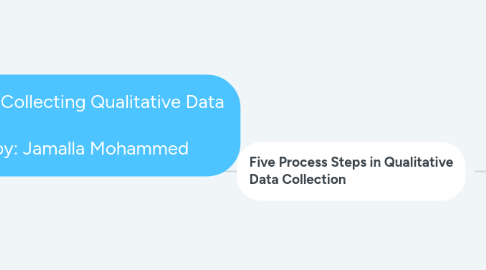
1. Five Process Steps in Qualitative Data Collection
1.1. In General
1.1.1. Qualitative researchers identify participants and sites through purposeful sampling.
1.1.2. Qualitative studies are usually conducted at the research site.
1.1.3. Qualitative studies rely on general interviews or observations not others’ instruments.
1.1.4. Qualitative researchers record information through self-designed protocols.
1.1.5. Qualitative studies require sensitivity to challenges and ethical issues from gathering face-to-face information, often in homes and workplaces.
1.2. Identify participants and sites (Purposeful Sampling)
1.2.1. Intent is not to generalize to a population, but to develop an in-depth exploration of a central phenomenon
1.2.1.1. random quantitative sampling
1.2.1.2. Purposeful Sampling
1.2.1.2.1. purposeful qualitative sampling
1.2.1.2.2. Types
1.2.1.2.3. Sample Size or Number of Research Sites
1.2.2. Quantitative focus is probability
1.2.3. Qualitative focus is the best understanding
1.3. Gain access to individuals and sites
1.3.1. What Types of Permissions Will Be Required to Gain Access to Participants and Sites?
1.3.1.1. Seek Institutional Review Board Approval
1.3.1.1.1. Gain permission from Institutional Review Board (I R B).
1.3.1.1.2. Gain permission from “gatekeepers” at the research site
1.3.1.1.3. Determine whether reviewers are family with qualitative inquiry.
1.3.1.1.4. Develop detailed description of procedures.
1.3.1.1.5. Detail how you will protect anonymity.
1.3.1.1.6. Discuss the need to respect the site and minimize disruption.
1.4. Identify what types of information will answer your research questions
1.4.1. Types
1.4.1.1. Observations
1.4.1.1.1. An observation is the process of gathering first-hand information by observing people and places at a research site.
1.4.1.1.2. Observational roles
1.4.1.1.3. Observational roles can be changed.
1.4.1.1.4. The Process of Observing
1.4.1.2. Interviews and questionnaires
1.4.1.2.1. Types of Interviews
1.4.1.2.2. General open-ended questions
1.4.1.2.3. Information is recorded, then transcribed for analysis
1.4.1.2.4. Conducting Interviews
1.4.1.3. Documents
1.4.1.3.1. Identify types of documents that may be useful
1.4.1.3.2. Consider public and private documents
1.4.1.3.3. Obtain permission before using documents
1.4.1.3.4. Provide specific instructions if you ask participants to keep a journal
1.4.1.3.5. Examine for accuracy, completeness, and usefulness
1.4.1.3.6. Optically scan documents when possible
1.4.1.4. Audiovisual materials
1.4.1.4.1. Images or sounds to help understand the central phenomenon
1.4.1.4.2. Examples
1.4.1.4.3. Are more difficult to analyze
1.4.1.4.4. Collecting Audiovisual Materials
1.5. Design protocols or instruments for collecting and recording information
1.5.1. Using Protocols: An Interview Protocol
1.5.1.1. Interview protocol:
1.5.1.1.1. Instructions for the process of the interview
1.5.1.1.2. The questions to be asked
1.5.1.1.3. Possible probes associated with each question
1.5.1.1.4. Space to take notes on responses from the interviewee
1.5.1.2. The header: Essential information about the interview, such as purpose, reminder to obtain consent and record.
1.5.1.3. Open-ended questions
1.5.1.3.1. “Ice-breaker”
1.5.1.3.2. Questions that address major research questions
1.5.1.3.3. Probes that clarify and elaborate
1.5.1.4. Include space between each question for notes
1.5.1.5. Closing comments thanking the participant
1.5.1.6. Sample
1.5.2. Using Protocols: An Observational Protocol
1.5.2.1. Used for taking field notes during an observation
1.5.2.2. In the header, record information about the time, place, setting, and your observational role
1.5.2.3. Divide the rest of the protocol into two columns:
1.5.2.3.1. Left column to record descriptive notes about the activities at the site
1.5.2.3.2. Right column to record reflective notes about themes, quotes, and personal experiences at the site
1.5.2.4. Include a sketch of the site
1.6. Administer the data collection
1.6.1. What Field and Ethical Issues Need to Be Anticipated?
1.6.1.1. Field Issues
1.6.1.1.1. Sufficient access to the site for data collection
1.6.1.1.2. Observational role
1.6.1.1.3. Building rapport with participants
1.6.1.1.4. Obtaining permission to use documents and audiovisual materials
1.6.1.2. Ethical Issues
1.6.1.2.1. Informing participants of purpose
1.6.1.2.2. Refraining from deceptive practices
1.6.1.2.3. Sharing your role as researcher
1.6.1.2.4. Being respectful of the research site
1.6.1.2.5. Giving back or reciprocity
1.6.1.2.6. Using ethical interview practices
1.6.1.2.7. Maintaining confidentiality
1.6.1.2.8. Collaborating with participants
1.6.2. Revisiting the Mothers’ Trust in Principals Qualitative Study
1.6.2.1. Wrote they plan on conducting a qualitative case study
1.6.2.2. Provided a justification for the use of the qualitative case study approach to understand processes across many cases
1.6.2.3. Discussed purposeful sampling and snowball sampling to recruit heterogeneous sample
1.6.2.4. Aware of field issues
1.6.2.5. Small sample
1.6.2.6. Face-to-face interviews and provided topics of questions
